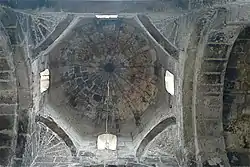
In architecture, a squinch is a triangular corner that supports the base of a dome.[1] Its visual purpose is to translate a rectangle into an octagon. See also: pendentive.
Construction

A squinch is typically formed by a masonry arch that spans a square corner.
History
The dome on squinches was already known in ancient Rome since early on. Although the Roman examples still standing that have survived to this day are late, the presence of square spaces that appear to have been covered by domes suggests that the technique was known very early. One of the most beautiful examples is the dome of the early Christian baptistery of San Giovanni in Fonte in Naples, whose dome and squinches are covered with mosaics from the 5th century (the construction of the baptistery, however, began in the 4th century). The fairly common "shell" motif found on Byzantine, Islamic and Romanesque horns is typically Roman (furnace vault and tympanum decoration in Roman architecture) and could be an indication of ancient sources of inspiration. However, the oldest known example of domes on squinches still standing is found in Sassanid architecture, in the 3rd century Ardacher Palace, a monument that displays some Roman influences elsewhere so the squinches there probably came from Roman influence.[2]
This technique was widely used in Byzantine and Armenian architecture, especially when the domes were not of large diameter. But this technique will be strongly challenged by pendentives, more suitable for large domes, as shown by that of the Hagia Sophia in Constantinople. Small domes on squinches also spread in Islamic architecture, where they were very common. They are often decorated with muqarnas that imitate cantilevered structures After the rise of Islam, it was used in the Middle East in both eastern Romanesque and Islamic architecture. It remained a feature of Islamic architecture, especially in Iran, and was often covered by corbelled stalactite-like structures known as muqarnas[3]
After the rise of Islam, it was used in the Middle East in both eastern Romanesque and Islamic architecture. It remained a feature of Islamic architecture, especially in Iran, and was often covered by corbelled stalactite-like structures known as muqarnas.
History in Western Europe
It spread to the Romanesque architecture of western Europe, one example being the Normans' 12th-century church of San Cataldo, Palermo, in Sicily. This has three domes, each supported by four doubled squinches.
Etymology
The word may possibly originate, the Oxford English Dictionary suggests, from the French word escoinson, meaning "from an angle", which became the English word "scuncheon" and then "scunch".[4][5]
References
- ↑ Webster's Ninth New Collegiate Dictionary, 1986, p. 1145
- ↑ Parker, John Henry (1989). A concise glossary of architectural terms. Internet Archive. London : Bracken Books. ISBN 978-1-85170-266-4.
- ↑ Parker, John Henry (1989). A concise glossary of architectural terms. Internet Archive. London : Bracken Books. ISBN 978-1-85170-266-4.
- ↑ "definition of Squinch". Oxford Living Dictionaries. Archived from the original on March 12, 2018. Retrieved 11 March 2018.
- ↑ "The definition of squinch". Dictionary.com. 2015. Retrieved 2015-10-24.
External links
 Media related to Squinches at Wikimedia Commons
Media related to Squinches at Wikimedia Commons